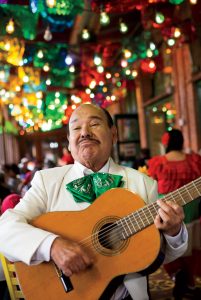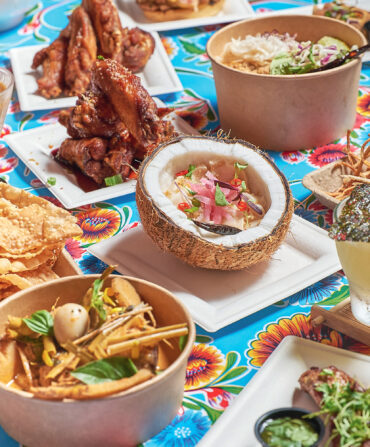City Guides
City Portrait: San Antonio, Texas

Photo: Buff Strickland
I once wrote a poem in the voice of an old man who gives bad directions in downtown San Antonio. On purpose, that is. I imagined him sitting in front of a stand of prickly pear cactus along what used to be Durango Boulevard (now Cesar E. Chavez Boulevard), wearily looking up as a carload of tourists asked directions to the Alamo. In the poem, the man spontaneously, and a little naughtily, steers them on toward a few things he considers more worth their time.
Of course the “man” in the poem is a thinly veiled version of me, and of course you should go see the mythic site of that battle between Mexican troops and Texan volunteer soldiers. It surprises many by being smaller than they expect, smack in the middle of downtown, and right across the street from the Ripley’s Believe It or Not! Odditorium. Whether our town’s most famous silhouette best symbolizes resilient heroism or the eventual conquest of valuable real estate is beyond the scope of this discussion. That too depends on whom you ask.
What I can promise is that everything you’ve heard about San Antonio is probably true, and that none of it is. The nation’s seventh-most populous city often behaves like a very small town. We’re rumored by national concert promoters to love our heavy metal, but klezmer- and conjunto-loving crowds pack the International Accordion Festival held each September, downtown in the historic art community La Villita. We’re politically and socially conservative, but a New York Times profile of wildly popular mayor Julián Castro went so far as to call us “a kind of Berkeley of the Southwest.” Okay, so maybe that one is a bit of a stretch, but you saw Castro give the keynote address at the Democratic National Convention, right? (Then again, that could have been his identical twin brother, Joaquin, currently serving his first term in the U.S. House of Representatives.) The mayor’s on Facebook, too, and a few days after posting a link to yet another recent article touting San Antonio as a hip and happening city, he posted a classic Tex-Mex still life taken on his own kitchen counter. There’s a flour tortilla warming on the stove, a container of barbacoa, a bottle of Big Red soda, an avocado, and a packet of chamoy, that weirdly addictive Mexican condiment made of chile, lime, and pickled fruit. The caption reads, “We’ve got it all this morning.”
So which San Antonio is it? The next big thing, or the same old breakfast tacos? I’d say that it’s both, and that this sometimes idiosyncratic combination of tradition, innovation, stubbornness, and charm, along with a particular mix of Western, Mexican, and Southern flavors, is what makes San Antonio so sweet, as well as surprising. Count me among the surprised, to have stayed, I mean. I learned to walk here, literally, in 1972, when my dad was stationed at Fort Sam Houston. Most of the base’s gates closed after 9/11, but you can still enter on foot at Grayson Street, and from there reach even further back in time inside the old 1876 Quadrangle. Bring the kids and a bag of carrots to feed the peacocks, geese, and deer that roam free inside the thick stone walls. You can even tell them the story about how Geronimo was once held captive here, but I don’t know if that’s really true either.
Our family eventually moved on, and when I returned twenty-some years later for a one-year teaching position, I assumed it would again be a temporary stay. I imagined I would eventually move north, eighty miles up I-35 to be exact, to Austin. Because if you had to live in Texas, you lived there, right? I never made it to Austin. I liked visiting, but it made me kind of tired to be so aware of how excited I should be to be there. San Antonio was sleepier, less shiny, and less self-conscious about its image. As Graham Greene once wrote, “You have the sensation in San Antonio by day of the world’s being deliciously excluded.” There were also fewer ironic mustaches.
In fact, San Antonio sometimes seems to lack an irony muscle altogether. Maybe it’s our military legacy, Teddy Roosevelt banging on the Menger Hotel bar “looking for a few good men.” Or maybe it’s the Mexican commitment to faith and familia. Whatever it is, we remain a little old-fashioned, refreshingly earnest in our efforts and affections. The guy who tries out to be Jesus and carry a cross down Main Street in the San Fernando Cathedral’s Good Friday procession really means it. So does my eighty-year-old neighbor who spells out GO SPURS GO with plastic cups stuffed into her chain-link fence. We really do love a parade. It doesn’t matter whether it’s spring’s Carnival-like Fiesta, where debutantes show off their cowboy boots beneath their $20,000 gowns and Cornyation drag queens show off more than that, marching terriers and Labs in Alamo Heights, or neighborhood kids blowing bubbles down King William Street. And heck, anybody who really plays the button accordion has got to mean it. If you ever heard the Texas Tornados’ Flaco Jimenez and Augie Meyers go at it on “(Hey Baby) Que Paso,” also known as the San Antonio national anthem, you know exactly what I mean. Even local artist Aaron Forland’s cheeky Keep San Antonio Lame guerrilla sticker campaign, a little jab at that Keep Austin Weird PR blitz, wasn’t meant to be ironic. We knew we weren’t as young and cool as them, and that was okay with us. Or maybe I just like an underdog. Maybe I do remember the Alamo.
So if I did take a wrong turn in getting myself here, then I’m grateful. Named for the patron saint of lost objects, San Antonio remains a wonderful place to get lost. The streets were built on top of cattle trails and acequias, and so twist illogically through downtown, often changing cardinal direction without warning. If you get turned around on the crowded bend of the famous River Walk, you may end up on St. Mary’s Street. Head south and look for Cascabel Mexican Patio. It will appear to be a hand-painted double-wide trailer, and I can’t promise that the hours listed on the sign will correspond to when it’s actually open, but if it is, try the huaraches. These thick soft corn tortillas are shaped like the sole of the sandal for which they are named, and piled high with shredded meat, cilantro, and onion. You have to bring your own beer, and for a long time they didn’t serve chips and salsa. (That’s Tex-Mex, and this is Mex-Mex.) But now a handwritten sign on the door says that they do. This is change I can live with. There’s an old man who sometimes eats lunch here, and if you ask him where to head next, chances are he’ll look up slowly, and point south. He’ll even sound a little poetic when he says you should keep going, on down to the part of the river where the sky widens with the silence of white egrets this time of year, and the silver fish shadow deeper with their secrets.









